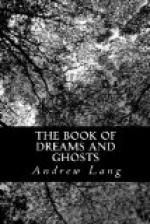“After this it was observed that that part of the young man’s body which had been on the mud in the quagmire was somewhat benummbed and seemingly deader than the other, whereupon the following Saturday, which was the day before Low Sunday, he was carried to Crediton, alias Kirton, to be bleeded, which being done accordingly, and the company having left him for some little space, at their return they found him in one of his fits, with his forehead much bruised, and swoln to a great bigness, none being able to guess how it happened, until his recovery from that fit, when upon enquiry he gave them this account of it: that a bird had with great swiftness and force flown in at the window with a stone in its beak, which it had dashed against his forehead, which had occasioned the swelling which they saw.
“The people much wondering at the strangeness of the accident, diligently sought the stone, and under the place where he sat they found not such a stone as they expected but a weight of brass or copper, which it seems the daemon had made use of on that occasion to give the poor young man that hurt in his forehead.
“The persons present were at the trouble to break it to pieces, every one taking a part and preserving it in memory of so strange an accident. After this the spirit continued to molest the young man in a very severe and rugged manner, often handling him with great extremity, and whether it hath yet left its violences to him, or whether the young man be yet alive, I can have no certain account.”
I leave the reader to consider of the extraordinary strangeness of the relation.
The reader, considering the exceeding strangeness of the relation, will observe that we have now reached “great swingeing falsehoods,” even if that opinion had not hitherto occurred to his mind. But if he thinks that such stories are no longer told, and even sworn to on Bible oath, he greatly deceives himself. In the chapter on “Haunted Houses” he will find statements just as hard narrated of the years 1870 and 1882. In these, however, the ghosts had no purpose but mischief. {118}
We take another “ghost with a purpose”.
SIR GEORGE VILLIERS’ GHOST.
The variations in the narratives of Sir George Villiers’ appearance to an old servant of his, or old protege, and the warning communicated by this man to Villiers’ son, the famous Duke of Buckingham, are curious and instructive. The tale is first told in print by William Lilly, the astrologer, in the second part of a large tract called Monarchy or No Monarchy in England (London, 1651), twenty-three years after Buckingham’s murder. But while prior in publication, Lilly’s story was probably written after, though independent of Lord Clarendon’s, in the first book of his History of the Rebellion, begun on 18th March, 1646, that is within eighteen years of the events. Clarendon, of course, was in a position to know what was talked of at the time. Next, we have a letter of Mr. Douch to Glanvil, undated, but written after the Restoration, and, finally, an original manuscript of 1652.




